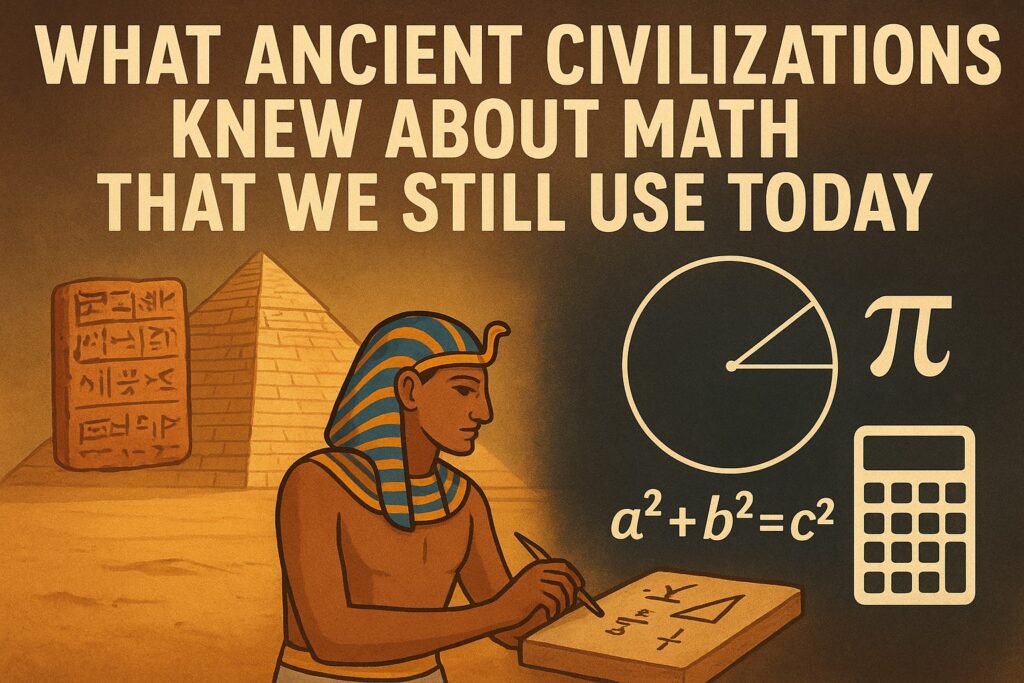By Swayam Nerkar
Mathematics is often seen as a modern science, a product of universities, research, and technological development. Yet, when we peel back the layers of history, we discover that ancient civilizations laid the groundwork for much of the mathematical knowledge we still use today. Far from primitive, cultures like the Babylonians, Egyptians, Greeks, Chinese, Indians, and Mayans developed sophisticated systems of numbers, geometry, algebra, and astronomy. These ideas did not vanish; instead, they became the backbone of everything from engineering and architecture to finance, computer science, and even the way we teach children arithmetic.
This article explores the most significant mathematical contributions of ancient civilizations, showing how their brilliance continues to shape the way we understand and apply mathematics in the 21st century.
The Birth of Numbers: Babylonian Contributions
The Babylonian civilization, which thrived around 1900 BCE in Mesopotamia, was one of the first societies to formalize mathematics. They are best known for their base-60 (sexagesimal) number system. While it may seem unusual compared to our decimal (base-10) system, its influence remains deeply embedded in our daily lives.
- Telling Time: We divide an hour into 60 minutes and each minute into 60 seconds because of the Babylonian system.
- Circles and Angles: A circle has 360 degrees, another inheritance from their base-60 structure.
Babylonian tablets also reveal knowledge of Pythagorean triples centuries before Pythagoras. Their clay tablets, like the famous Plimpton 322, show calculations involving right-angled triangles and principles that underpin trigonometry.
The Egyptians: Masters of Practical Mathematics
The Egyptians were renowned for their practical applications of mathematics, particularly in geometry. Living along the Nile River meant their farmlands were regularly flooded, erasing boundaries. To solve this, Egyptians developed methods to measure land, calculate areas, and reconstruct property lines—a process that gave birth to the word “geometry” itself, meaning “earth measurement.”
- Pyramids and Architecture: The Great Pyramid of Giza embodies advanced geometrical knowledge. Its proportions reflect precise use of triangles, symmetry, and ratios.
- Fractions and Arithmetic: Egyptians used unique methods for fractional calculations, which influenced later Greek and Roman mathematics.
Their mathematical papyri, such as the Rhind Mathematical Papyrus, illustrate techniques for solving equations, understanding proportions, and applying formulas that are still relevant in construction and engineering today.
Greece: The Theoretical Foundation of Mathematics
The Greeks took mathematics from the practical realm into the world of logic, proofs, and theory. For them, math was not just a tool but a philosophy.
- Pythagoras and Geometry: The Pythagorean theorem, stating that a² + b² = c² in a right triangle, is still taught universally.
- Euclid and The Elements: Euclid compiled one of the most influential textbooks in history, The Elements, which systematized geometry into axioms and proofs. For centuries, it was the standard for teaching mathematics.
- Archimedes and Calculus Foundations: Archimedes’ work on areas, volumes, and levers laid the groundwork for integral calculus long before Newton and Leibniz.
The Greek emphasis on rigorous proofs forms the basis of modern mathematical reasoning. Even today, fields like computer science, cryptography, and data science rely heavily on the logical structures pioneered in Greek mathematics.
India: The Birthplace of Zero and Algebra
If one single contribution changed mathematics forever, it was the invention of zero—a concept that came from ancient India. Indian mathematicians such as Aryabhata, Brahmagupta, and later Bhaskara II advanced revolutionary ideas that shaped global mathematics.
- The Concept of Zero: Not just a placeholder, zero became a number in its own right, enabling the place-value system we use in modern arithmetic.
- Decimal System: India gave the world the base-10 numeral system, which spread through the Arabs to Europe and became universal.
- Algebra: Indian texts introduced early forms of algebraic equations and methods for solving quadratic and indeterminate problems.
Without Indian contributions, today’s banking, accounting, digital coding, and computing would be impossible. Every calculation we do on a smartphone or computer rests on the Indian number system.
China: Early Innovations in Algebra and Astronomy
The Chinese civilization developed mathematics with both practical and theoretical insights. Their work emphasized problem-solving, algorithms, and patterns.
- The Nine Chapters on the Mathematical Art: This ancient text outlined methods for solving linear equations, calculating areas and volumes, and even matrix methods, which resemble modern linear algebra techniques.
- Magic Squares and Combinatorics: Chinese mathematicians studied number patterns that influenced probability and game theory centuries later.
- Astronomy and Calendars: Chinese experts used mathematics for predicting eclipses, designing calendars, and mapping the heavens.
Their structured approach to algebra and problem-solving still echoes in how mathematics is taught today.
The Mayans: Masters of Astronomy and Calendrics
In the Americas, the Mayan civilization achieved extraordinary feats in astronomy and mathematics.
- Vigesimal System: They used a base-20 system, which, though different from the decimal system, was remarkably efficient.
- Zero in the Americas: The Mayans independently discovered zero, a critical concept for calculation.
- Calendrical Mathematics: They developed incredibly accurate calendar systems, some of which rival modern astronomical calculations in precision.
Their understanding of cyclical time and astronomy demonstrates how mathematics can emerge from cultural and environmental needs.
Rome: The Engineers of Mathematics
Though the Romans were less theoretical than the Greeks, they excelled at practical mathematics in the service of engineering and empire-building.
- Roman Numerals: Though cumbersome compared to the Indian decimal system, they are still used today in clocks, book chapters, and monuments.
- Surveying and Construction: Roman roads, aqueducts, and bridges relied on geometrical precision.
- Military Applications: Mathematics was applied to logistics, fortifications, and even war machinery.
Their focus on applied mathematics ensured that theoretical concepts were translated into real-world innovations.
How Ancient Mathematics Shapes Modern Society
The brilliance of ancient mathematics lives on in the modern world. From the algebraic equations we solve in school to the geometry used in architecture and the number systems underpinning digital technology, the connections are everywhere.
- Architecture and Engineering: Modern skyscrapers use Egyptian geometry and Greek ratios.
- Timekeeping and Navigation: The Babylonian base-60 system governs how we measure time and angles.
- Computer Science: The Indian numeral system and binary concepts owe their roots to early ideas of zero and place value.
- Astronomy and Space Exploration: The Mayan and Chinese astronomical systems paved the way for our calculations of orbits and celestial movements.
Even the way mathematics is taught—in axiomatic steps, logical proofs, and problem-solving exercises—reflects the influence of Greek and Indian traditions.
Why Ancient Mathematics Still Matters
Studying ancient mathematics is more than a historical curiosity. It reveals how human societies, without modern tools, unlocked universal truths about numbers, shapes, and patterns. These discoveries remind us that mathematics is a shared human heritage, born not in one place, but through the contributions of many civilizations across continents.
It also challenges the modern assumption that innovation only belongs to the present. Long before supercomputers, satellites, or artificial intelligence, people with simple tools—sticks, clay tablets, papyrus, or carved stone—were asking the same fundamental questions about the universe that we continue to ask today.
Conclusion
The mathematical achievements of ancient civilizations are not relics of the past—they are the foundation of the present. From the Babylonians’ base-60 system to the Indian invention of zero, from the geometry of Egypt and Greece to the astronomy of the Mayans and Chinese, these contributions continue to shape our modern world in profound ways.
Mathematics is often called the universal language, and ancient civilizations were its first poets. Every time we check the time, calculate an angle, solve an equation, or marvel at a skyscraper, we are unknowingly paying homage to the mathematical wisdom of our ancestors.
The next time you open a calculator app or study a geometric diagram, remember: you are engaging with knowledge that has traveled thousands of years, across continents, nurtured by cultures long gone yet eternally alive in the numbers and patterns that define our world.







